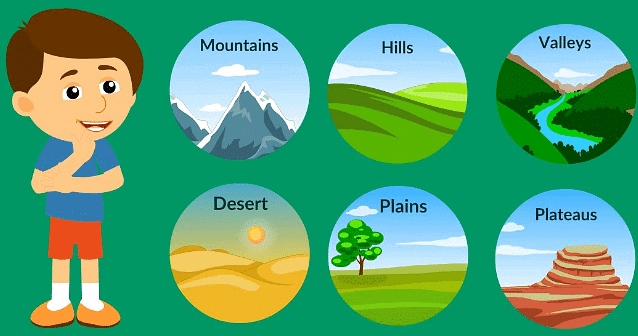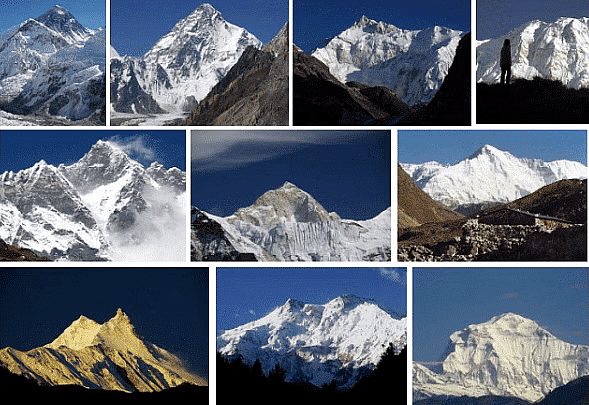Major Landforms - 2 Class 5 Worksheet SST
 Q1: Fill in the Blanks
Q1: Fill in the Blanks
(i) Mountains are prominent __________ that tower over the surrounding terrain.
Ans: landforms
(ii) The highest plateau globally is known as the Plateau of __________.
Ans: Tibet
(iii) Deserts are barren and __________ regions with minimal rainfall.
Ans: arid
(iv) Rivers originate from __________ regions and flow towards oceans or other bodies of water.
Ans: mountainous
(v) When several mountains are connected, they form a mountain __________.
Ans: range
(vi) The Himalayas are an example of __________ mountains characterized by rugged relief.
Ans: fold
(vii) Plateaus are highland areas characterized by __________ surfaces.
Ans: flat
(viii) The Deccan Plateau is located in __________.
Ans: India
(ix) Deserts can be categorized as hot deserts and __________ deserts.
Ans: cold
(x) The lower course of a river is characterized by its division into multiple __________.
Ans: channles
Q2: Multiple Choice Questions (MCQs)
(i) What are mountains primarily composed of?
(a) Sand and water
(b) Rocks and earth
(c) Soil and plants
(d) Concrete and metals
Ans: (b)
Mountains are composed of various types of rocks and earth materials that make up their structure and appearance.
(ii) The highest plateau globally is known as:
(a) Sahara Plateau
(b) Deccan Plateau
(c) Plateau of Tibet
(d) Rocky Plateau
Ans: (c)
The Plateau of Tibet is often referred to as the "roof of the world" due to its high elevation and extensive size.
(iii) Deserts are characterized by:
 (a) Heavy rainfall
(a) Heavy rainfall
(b) Dense vegetation
(c) Minimal rainfall and extreme conditions
(d) Frequent snowfall
Ans: (c)
Deserts are known for their arid conditions, with very little rainfall and extreme temperature fluctuations.
(iv) Which landform often contains oases?
(a) Mountains
(b) Rivers
(c) Plateaus
(d) Deserts
Ans: (d)
Oases are small areas within deserts where water is present, allowing vegetation to grow and providing a habitat for both plants and people.
(v) What is the final stage of a river's journey called?
(a) Upper Course
(b) Middle Course
(c) Lower Course
(d) River Mouth
Ans: (c)
The lower course of a river is the final stage of its journey when it reaches a larger body of water, such as a sea or an ocean.
Q3: True or False
(i) Plateaus are characterized by steep slopes on all sides.
Ans: False
Plateaus are characterized by relatively flat surfaces, often dissected by rivers and streams, and they may have steep slopes on one or more sides.
(ii) Mountains are primarily formed by river deposits.
Ans: False
Mountains are primarily formed by tectonic processes, volcanic activity, and erosion, not by river deposits.
(iii) Cold deserts have scorching hot temperatures.
Ans: False
Cold deserts have extreme temperature variations, including cold nights, but they are not characterized by scorching hot temperatures like hot deserts.
(iv) The middle course of a river is characterized by deep valleys and waterfalls.
Ans: False
The middle course of a river is characterized by reduced speed, meandering, and the formation of loops, not deep valleys and waterfalls.
(v) Oases are areas within deserts where water is scarce.
Ans: False
Oases are small areas within deserts where water is available, making them relatively more fertile and hospitable compared to the surrounding arid areas.
Q4: Match the Following
(i) Fold Mountains ⇒ (a) Expansive and flat
(ii) Deserts ⇒ (b) Tower over surrounding terrain
(iii) Plains ⇒ (c) Minimal rainfall and extreme conditions
(iv) Rivers ⇒ (d) Rugged relief and high conical peaks
(v) Plateaus ⇒ (e) Natural freshwater channels
Ans:
(i) Fold Mountains ⇒ (d) Fold Mountains
(ii) Deserts ⇒ (c) Deserts
(iii) Plains ⇒ (a) Plains
(iv) Rivers ⇒ (e) Rivers
(v) Plateaus ⇒ (b) Plateaus

Q5: Short Answer Questions
(i) Explain the role of mountains as natural barriers.
Ans: Mountains act as natural barriers by shielding regions from harsh winds, extreme temperatures, and potential invasions. Their rugged terrain makes it difficult for invaders to cross, providing protection to the areas beyond them.
(ii) How are plateaus formed, and why are they important for agriculture?
Ans: Plateaus are formed through various geological processes, such as volcanic activity, tectonic uplift, and erosion. They are important for agriculture because they often have fertile soils due to river deposits. These regions can support farming and grazing activities. Plateaus with significant heights may also have waterfalls that enhance their natural beauty and provide resources for irrigation.
(iii) Differentiate between hot deserts and cold deserts.
Ans: Hot deserts and cold deserts differ primarily in their temperature characteristics. Hot deserts have scorching hot temperatures during the day and can experience relatively mild nights. Cold deserts, on the other hand, have extreme temperature fluctuations with very cold nights, and they can experience snowfall.
(iv) Describe the three stages of a river's journey.
Ans: The three stages of a river's journey are:
- Upper Course: The river starts in the mountains, characterized by steep slopes and minimal water flow. Deep valleys and waterfalls may form as the river gains speed.
- Middle Course: The river enters the plains, and its speed decreases as it flows on flatter terrain. Meandering becomes prominent, and loops form in this stage.
- Lower Course: The river reaches its final destination, often merging with a larger water body. It divides into multiple channels, and sediment accumulation leads to the formation of a delta.
(v) Why are oases significant in desert regions?
Ans: Oases are significant in desert regions because they provide relief amidst the arid surroundings. These small areas with water support the growth of vegetation, allowing settlements and agriculture to thrive. Oases serve as important resources for both people and animals in desert regions.
|
33 videos|264 docs|50 tests
|
FAQs on Major Landforms - 2 Class 5 Worksheet SST
| 1. What are major landforms? |  |
| 2. How are mountains formed? |  |
| 3. What causes valleys to form? |  |
| 4. How do plateaus differ from mountains? |  |
| 5. What are the main characteristics of plains? |  |
















